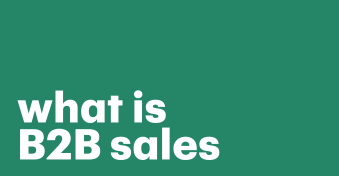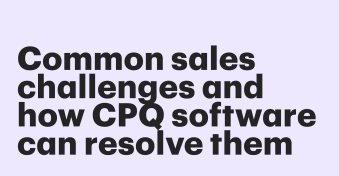Sales order vs invoice? That is the question.
If you’re in an organization that buys or sells things regularly, you’re probably familiar with the terms “sales orders” and “invoices.”
Knowing the difference between these two terms is crucial if you want to make sure your business runs smoothly.
That’s why we’ve put together this comparison guide, including invoice and sales order definitions, examples, types of sales orders vs invoices, and tips for creating sales orders and invoices.
Key takeaways
- Sales orders are used to track purchases when a customer requests a purchase.
- Invoices are used once the purchase has been completed to ensure payment.
- When you’re creating sales orders and invoices, it’s important to include elements such as company details, customer information, and payment terms.
- Both sales orders and invoices can be improved by using PandaDoc’s automated payment solutions.
Before we start to think about sales order vs invoice, we need to know exactly what we’re talking about.
What is a sales order?
A sales order comes from a request by a customer looking to make a purchase.
It essentially confirms that a transaction can take place and is used to store information about the sale.
Here’s a breakdown of the essential information you should include when producing a sales order:
- Company details: Like any formal document, you should include the most important details about your organization, such as the company name, location, and contact details.
- Products purchased: The most important part of any sales order is the products or services the customer has purchased. This needs to be as detailed as possible—make sure to include the product’s SKU, how much the customer has ordered, and the price of the products.
- Customer information: Include key details about the client, such as their name and contact information. It’s also important that you log their shipping and billing addresses on the sales order.
- Shipping details: The sales order needs to make it clear how the order will be fulfilled. Is the customer going to collect it, or are the products going to be shipped? If you’re shipping the product, you should also include details such as the estimated delivery date and any additional shipping costs.
- Balance and accounting information: Add the balance of the order and any other information that your company will use to manage your accounts.
- Payment terms: In a sales order, customers expect to see the payment terms. This is especially important if the sales order is produced before payment has been completed.
What is the purpose of a sales order?
Sales orders have a range of purposes.
Most importantly, a sales order confirms that the seller has the goods—or the ability to provide the services—that the buyer has requested.
By creating a sales order, the seller is showing that they have checked the items that the buyer wants and that they’re certain they can provide them.
As well as this, sales orders are a great way to document the details of every order that customers make.
As they contain information about the customer, as well as details relating to the products that they’ve ordered, they’re used to stay on top of all your different orders and customers.
By enabling your organization to track your sales, customers, and inventory, sales orders let you improve the productivity of your organization — you won’t have to waste time worrying about the status of your orders if you use sales orders effectively.
When do you use a sales order?
Sales orders are used as soon as a customer has placed an order.
In most workflows, sales document templates are used to automatically create a sales order that can then be sent to the relevant parties.
Often, the sales order will come after the customer has paid for the products.
Sales orders are also used after the goods have been received by the customer.
That’s because they’re often used as a receipt to ensure the buyer has received exactly what they’ve paid for.
Types of sales orders
There are four main types of sales orders you’ll come across when buying and selling goods as a business:

1. Scheduling agreement
Scheduling agreements are sales orders that focus on the practicalities of getting the goods to the customer.
This means that they’re used to specify things such as delivery dates or the quantities of goods.
Scheduling agreements are commonly used to manage production workflows as they give a clear picture of what orders need to be processed and when they need to be processed.
They’re also useful for managing relationships with external delivery companies, as they can be updated when the goods are delivered.
2. Cash sales
This is a very simple type of sales order—the customer just places the order and pays for it when they collect the order.
As this is a cash sale, the sales order accounts for the sale even though you won’t receive an account receivable.
3. Third-party sales order
For small businesses that don’t have the scale to complete and deliver orders themselves, third-party sales are very popular.
This is because this is a method of sales order that allows you to monitor a sale managed by a third-party vendor.
If you’re using a third-party sales order, you’ll complete a sales order as usual as soon as an order is placed.
However, this sales order will then be passed to the third party who assumes full responsibility for ensuring that the sale is completed.
4. Rush sales order
Rush sales orders are used when customers receive the goods or services before the payment is completed.
This is useful for sudden transactions, and they’re a good way of ensuring that you’ll receive payment later, as your accountants can use the sales order to monitor missing payments.
Example of a sales order
If you’re looking for an example of a sales order, you should simply use PandaDoc’s sales document templates.
These templates can be adapted to accommodate your organization’s unique needs while also ensuring that you can easily include all of the key details that we’ve explained above. Read more about our CPQ software.
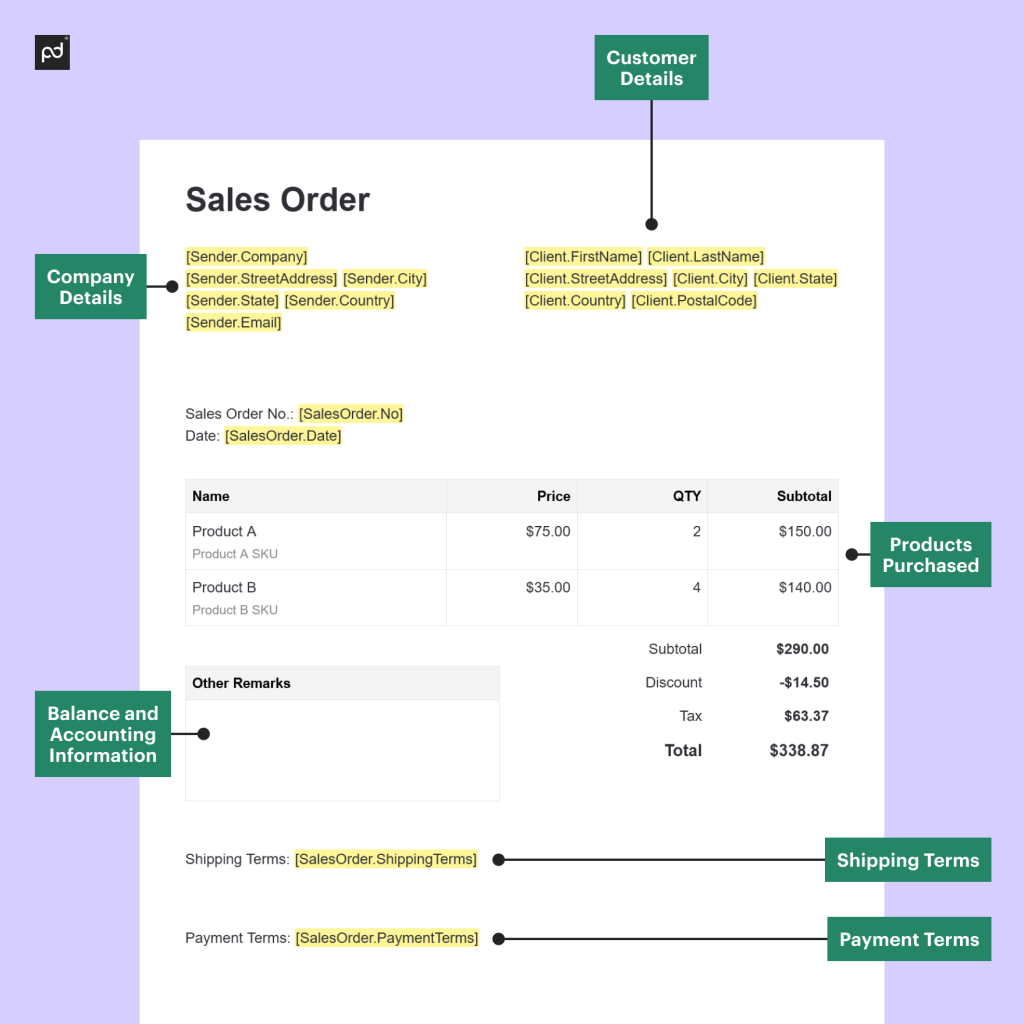
What is an invoice?
Now that you know what a sales order is, what is an invoice?
Invoices are documents that businesses send to clients when they need to request a payment.
Let’s say that a customer has requested a product—this would create a sales order.
When that sales order has been completed, an invoice should be used to ensure that you receive the payment outline in that sales order.
Why is an invoice important?
Invoices are a crucial part of business.
Without them, you’ll have no mechanism to make sure that you receive the payment that you’ve agreed with a customer.
As well as this, invoices are a great way of tracking and monitoring your debts and profits.
By creating an invoice every time you need to request a payment, you’ll have a paper trail that can be used to stay on top of all of your transactions.
When do you use an invoice?
If you’re wondering when you use an invoice, you need to consider it the mirror image of a sales order.
While sales orders are used as soon as an order is placed, an invoice should be used as soon as an order is fulfilled.
This means you can receive payment quickly, preventing any issues with your cash flow.
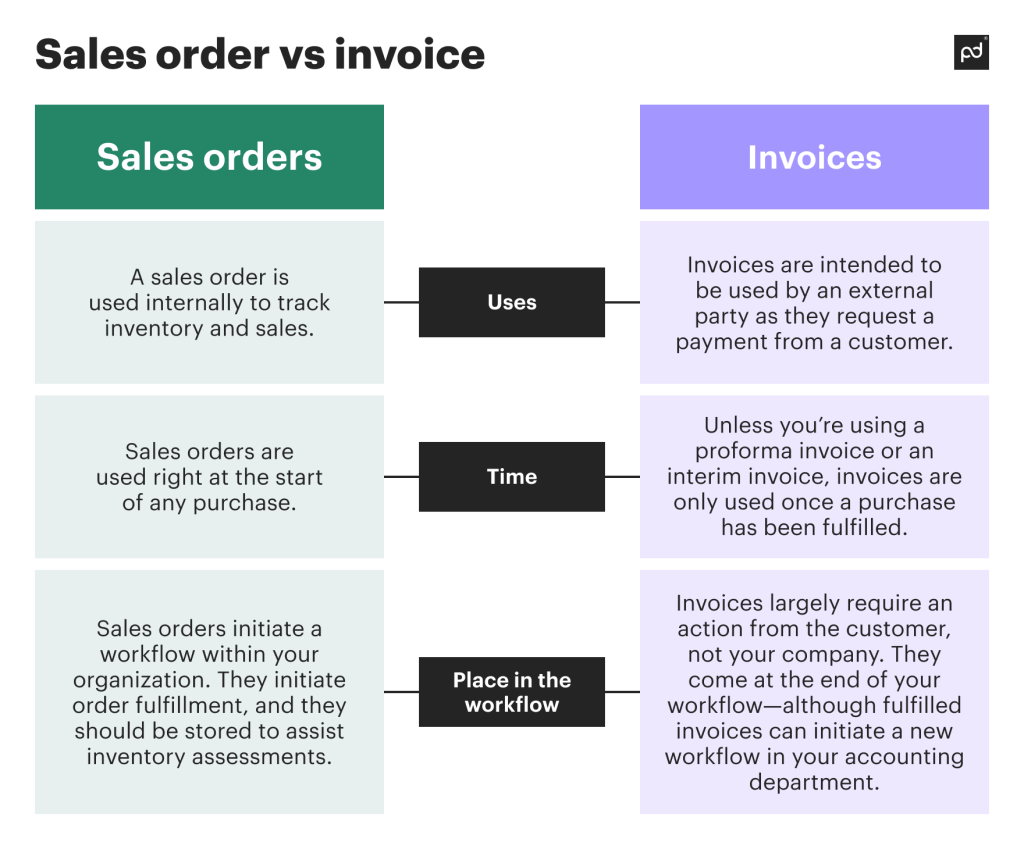
Types of invoices
Just like with sales orders, there are a few different invoices.
When it’s time to make an invoice, you’ll want to know which specific type of invoice you need to create—so here are the most popular forms of invoices:
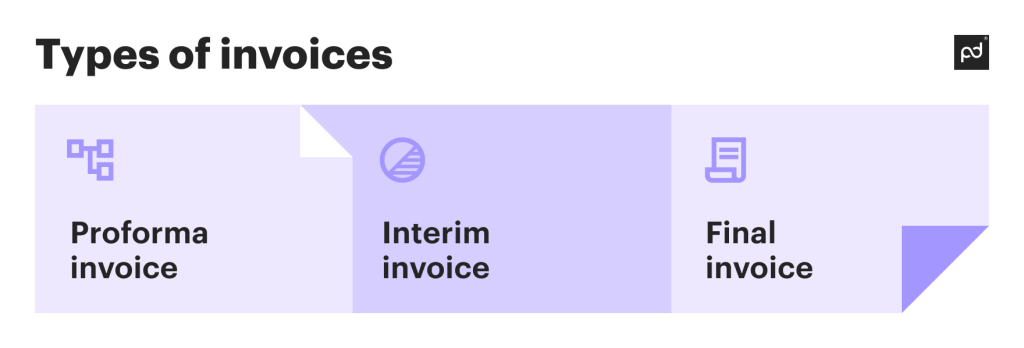
1. Proforma invoice
Think of a proforma invoice as a live document that is accessible to all parties while a project is being completed.
It allows customers to see what they’ll need to pay and when they’ll need to pay it.
The point of using a proforma invoice is to account for any changes, meaning that it’s popular for complex projects.
2. Interim invoice
Similar to the proforma invoice is the interim invoice. This is when costs are spread out across the project.
Rather than receiving your payment once all of the services have been completed, an interim invoice can be used to request a chunk of your overall payment during the project.
3. Final invoice
This is by far the most popular invoice.
That’s because it’s an invoice that simply bills a customer once the goods have been delivered or the service has been provided.
It’s called the final invoice because it comes once the project is completed—the customer will know what they’re paying and why they’re paying it.
What to include on an invoice
If you’re wondering how to write an invoice, here are the key details that you’ll need to include:
- Unique reference number: In order to aid the tracking and monitoring of different invoices, you should always include a unique reference number on every invoice that you send.
- Company details: Company details are crucial, so include the usual things such as company name, location, and contact details. However, you must also include information about how the customer can pay your company—try to allow for multiple different payment options.
- Customer details: Similarly, the invoice should include customer details such as their contact information and shipping information.
- Breakdown of products or services: As the invoice is requesting a payment, it should clearly state the reasons for that payment. Break down the products or services the customer has bought so there is no reason for the customer to query your request.
- Payment terms and dates: In order to make the payment as smooth as possible, you should clarify the date by which you’ll need to be paid. Alongside this, include terms and conditions that specify the consequences of late payment.
Example of an invoice
There are lots of invoice templates that you can use as examples of invoices.
Using these templates is a great way to ensure that you include everything that you need to include in your invoice.
Templates also help you speed up the invoicing process.
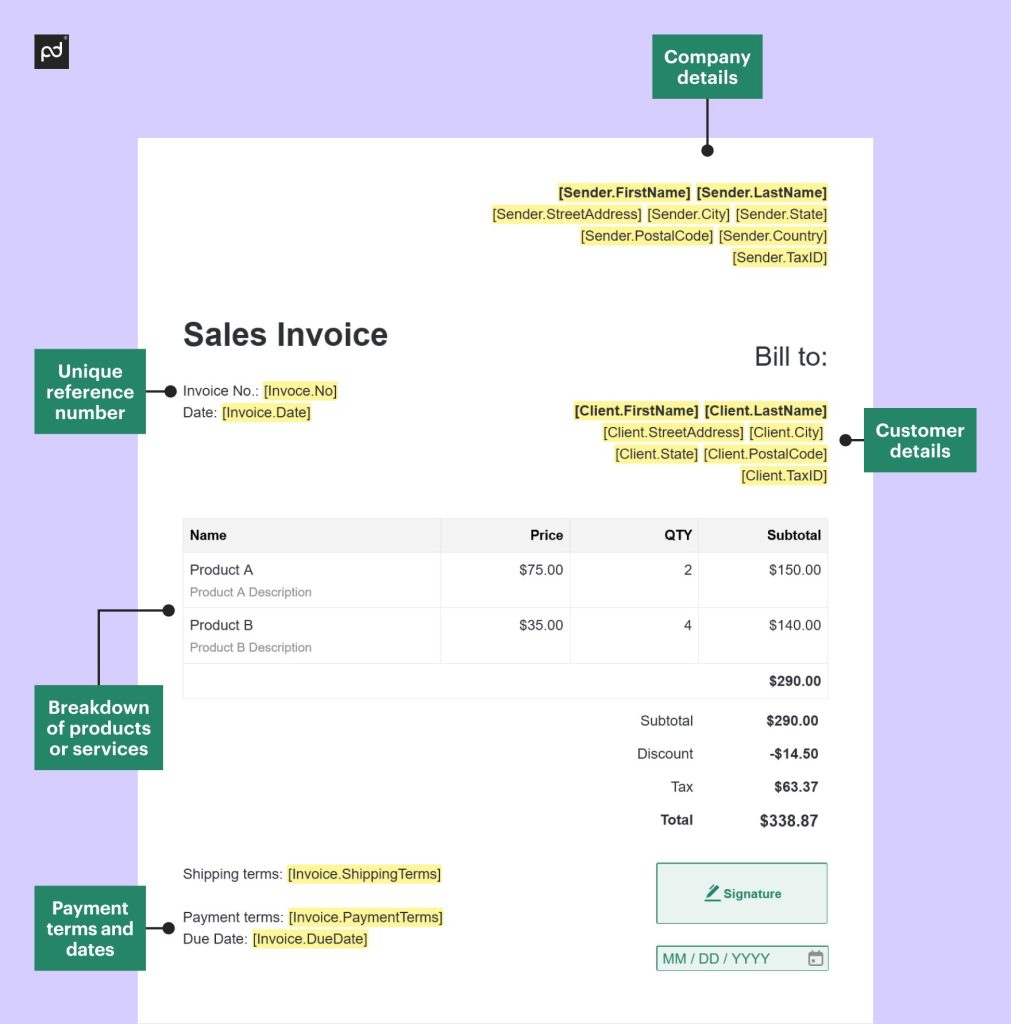
What is the difference between sales order and invoice?
| Sales orders | Invoices | |
|---|---|---|
| Uses | A sales order is used internally to track inventory and sales. | Invoices are intended to be used by an external party as they request a payment from a customer. |
| Time | Sales orders are used right at the start of any purchase. | Unless you’re using a proforma invoice or an interim invoice, invoices are only used once a purchase has been fulfilled. |
| Place in the workflow | Sales orders initiate a workflow within your organization. They initiate order fulfillment, and they should be stored to assist inventory assessments. | Invoices largely require an action from the customer, not your company. They come at the end of your workflow—although fulfilled invoices can initiate a new workflow in your accounting department. |
What is the difference between sales order and invoice?
| Sales orders | Invoices | |
| Uses | A sales order is used internally to track inventory and sales. | Invoices are intended to be used by an external party as they request a payment from a customer. |
| Time | Sales orders are used right at the start of any purchase. | Unless you’re using a proforma invoice or an interim invoice, invoices are only used once a purchase has been fulfilled. |
| Place in the workflow | Sales orders initiate a workflow within your organization. They initiate order fulfillment, and they should be stored to assist inventory assessments. | Invoices largely require an action from the customer, not your company. They come at the end of your workflow—although fulfilled invoices can initiate a new workflow in your accounting department. |
What are the similarities between invoice vs sales order?
Although there are significant differences between invoices and sales orders, there are also some crucial similarities:
- Purchase cycle: Both invoices and sales orders are facilitating documents in the same purchase cycle. They should be used to start and end a purchase.
- Key information: Although there are some crucial differences in the key information in invoices vs sales orders, you should include things such as contact details and product information on both documents.
- Accountancy: Invoices and sales orders are both incredibly useful in the accounting process. It’s therefore crucial that you use them both productively and ensure that they’re always accurate.
Use cases and examples
Sales order example:
A customer orders 100 units of a specific product from a supplier. The supplier generates a sales order detailing the product name, SKU, quantity, unit price, total price, customer information, shipping method, and expected delivery date. The sales order is an internal confirmation document to process and fulfill the order.
Invoice example:
After delivering the 100 units to the customer, the supplier issues an invoice requesting payment. The invoice includes the supplier’s details, invoice number, date, billing address, description of goods delivered, quantities, unit prices, total amount due, payment terms, and due date. This document serves as an official request for payment and is used for accounting and tax purposes.
Understanding the distinct roles of sales orders gives you clarity about the transaction process and helps you maintain accurate financial record-keeping.
Automating the sales order and invoice process
Another key similarity between sales orders and invoices is that the processing of these two documents can benefit from automation.
Here are the main ways in which automation can improve your sales orders and invoices:
Tracking and monitoring
When a sales order has been created, automated processes can immediately track and monitor that sales order.
This will ensure that any delays are quickly picked up by sales order automation software and can be swiftly rectified.
Matching
Automated matching processes can quickly match the data on an invoice with the data on a sales order.
This will rapidly improve your processing as well as reduce the likelihood of human error.
Scanning and approval
Entering the details of every invoice manually is a time-consuming task.
Instead, you should use software to automatically scan and approve invoices, allowing you to quickly and accurately process invoices.
Say goodbye to errors and manual handling with PandaDoc Payments
Seamlessly integrate payment gateways into your documents for efficient, error-free transactions.
Reduce your average payment time to 2 days with PandaDoc payment solutions software
Although there are important differences between sales orders vs invoices, they’re both crucial parts of the purchase cycle for your organization.
That means that it’s imperative that you find a way to make the processing of sales orders and invoices as efficient as possible—and that’s where PandaDoc’s payment software comes in.
Including features such as sales order automation, PandaDoc’s payment solution is a great way to automate your sales orders and invoices, reducing your average payment time to two days.
Frequently asked questions
-
The sales order precedes the invoice in the sales process. The sequence typically follows these steps:
Purchase Order (PO): The buyer issues a PO to request goods or services.
Sales Order (SO): The seller creates a sales order to confirm receipt of the PO and outline the sale details.
Delivery: The seller delivers the goods or services as agreed.
Invoice: After delivery, the seller issues an invoice to request payment.
-
Invoices are only needed if payment isn’t given ahead of goods being delivered.
-
Payment sometimes accompanies a sales order, but this isn’t necessary.
-
Sales orders are a legally binding contract between the buyer and seller.
-
Purchase orders are similar to sales orders, but purchase orders just refer to the buyer’s perspective as they are used in the buying organization to monitor purchases.
-
No, a sales order and an invoice serve distinct purposes in the sales process and are not interchangeable. A sales order confirms the details of a customer’s purchase request and is used internally to process the order. An invoice is a formal request for payment issued after the goods or services have been delivered. Using a sales order as an invoice could lead to confusion and accounting inaccuracies.
